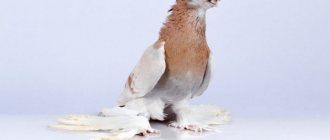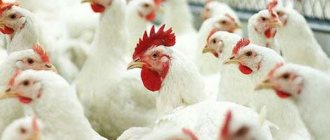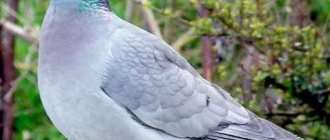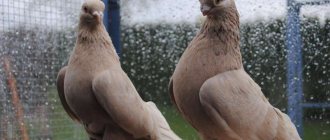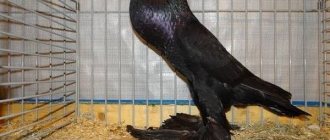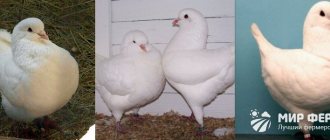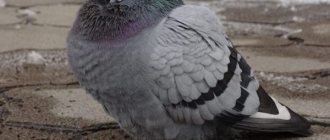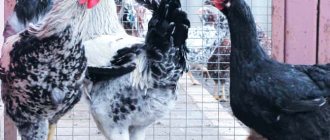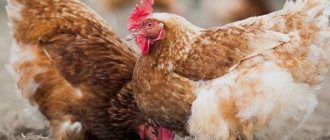Historical data
Stately pigeons are not identified in world catalogs as a separate group. In Russia it has been there since 1982. The Don and Kuban lands are considered the homeland of these birds - the stately breeds have been bred here for about 200 years. Later, these pigeons appeared in the Volga region, then in the Urals in Siberia.
Stately breeds are constant participants in pigeon exhibitions held in Russia. As a result of selection, many varieties have been bred; each new line is named after the area where they were bred.
The breed was first introduced to the world in 1975 at the Budapest exhibition. Here, Russian pigeon breeders showed Rostov white-breasted pigeons, which received the highest marks and earned the sympathy of the audience. In Czechoslovakia, at an exhibition in 1980, the Volga ribbon pigeon rightfully received the title of champion.
History of formation
Stately pigeons can be seen all over the world, but when compiling catalogs they are not singled out as a separate group. In our country they have been allocated since 1982. Most of the birds live in populated areas of the Azov region, Don, and Volga. Some moved to Siberia and the Southern Urals.
Stately pigeons are attracting more and more interest; not a single exhibition is complete without displaying these breeds. The Budapest exhibition in 1975 accepted this breed for the first time; it was there that Rostov white-breasted pigeons were demonstrated, where they won both the highest marks from judges and the love of the audience. And already in 1980, when the exhibition was held in Czechoslovakia, the Volga ribbon pigeon was rightfully recognized as the champion.
What should the “statistics” indicators be?
“Stateness” in pigeon breeds is determined by external signs. All representatives of stately breeds are united by a unique physique and graceful posture. The appearance is characterized by the following features:
- wide raised chest;
- tail with one to two dozen tail feathers;
- winged, the wings should be lower than the tail.
In total, pigeon breeders distinguish three subgroups of stately breeds:
- shakers;
- Kachunov;
- visoptera.
Belonging to one of the above subgroups is established in one of the following ways:
- The relationship of the position of different parts of the body to a horizontal surface. Indicators are measured in degrees. This method is quite complicated and requires measurements and calculations.
- The positions of different parts of the body relative to a vertical line - it runs from the pigeon’s paws, up along the body. Pigeon breeders determine, in particular, how the head, body, wings, neck, and tail are located relative to this line.
In the first and second cases, when determining the bird's position, they look at it in profile. Let's take a closer look at the varieties of pigeons that differ in the article.
Signs of stately breeds of pigeons
Characteristic features of stately breeds of pigeons are a raised, wide chest, drooping ends of the wings below the tail and a raised, wide tail with 12 to 20 feathers.
According to the figure and position of body parts (statistically), stately pigeons must be divided into three subgroups: lop-winged, shakers and rockers. This is especially important when evaluating exhibits at exhibitions and competitions.
1. Pigeons are mostly medium-sized and small, have lowered wings below the tail, sometimes touching the floor, and a raised tail, a neck without shaking. The dove seems to fit into a horizontal rectangle.
2. Shakers are small and medium-sized, have a short body, raised chest, elongated neck with a bend and shake, and a high tail.
3. Kachuns have a very shortened body, a highly raised chest, an elongated neck with a bend and shake, a relatively short tail, flat and strongly raised. The dove fits into a vertical rectangle.
Determination of membership in this or another subgroup of stately pigeons can be based on the following indicators:
- by the angle, expressed in degrees, of the position of body parts in relation to the horizontal surface along which the pigeon walks in a calm position. This method is relatively complex;
- by the position of the head, neck, body, wings and tail of a pigeon while walking in a calm state in relation to the vertical of the mentally extended legs through the body and above.
Types of stately pigeons
Stately pigeons are divided according to their external and flight characteristics. External characteristics allow us to distinguish three subgroups of breeds.
Eloptera
These birds are medium in size, less often small. A characteristic feature is the low-hanging tips of the wings. The ends of the wings are below the level of the tail, they can even reach the horizontal surface on which the pigeon sits. The tails of lop-winged pigeons are raised, their neck is at rest - it does not shake.
Popular lop-winged breeds:
- Dubovsky;
- Kamyshinsky;
- Rzhevsky;
- Syzran;
- Kryukovsky and others.
Kachuny
Kachunov have a short body, a raised chest, and a long, beautifully curved neck. When moving on foot, the birds sway, hence the name. There are many breeds of Kachunov bred in Russia:
- Novocherkassk blacktails;
- Rostov stately;
- white-breasted and others.
Shakers
Shakers have a short body and an elongated, gracefully curved neck. Their chest is classically raised, the tail is quite wide, and also lifted up. A distinctive feature due to which this subgroup of birds got its name is the frequent shaking of its neck.
Kazan Shaker
Popular shaking pigeons:
- Kazan;
- chistyaki-chiliki;
- Poltava black-tailed;
- Uryupinsk blue;
- Lugansk;
- Voronezh beetles;
- Volga red-breasted;
- Yeisk two-foreheads and others.
Classification of pigeons by subspecies
In general, all Stately pigeons are divided into three main subspecies:
Each has a number of characteristic features.
Eloptera
The birds were so named because when they walk, their wings hang very strongly and practically touch the ground. Their bodies are medium in size. This group includes the following types:
Shakers
Nature has endowed these birds with very compact sizes.
Their characteristic feature is an elongated, curved neck region, which is why their head constantly shakes. The tail part of all shakers is slightly raised.
This group includes the following species:
- Chistyak-chilik,
- Lugansky,
- Poltavsky,
- black-tailed,
- Volzhsky red-breasted.
Kachuny
These birds also have a short body, but with a large, highly raised chest. The neck of the Voronezh breed and other Kachunov also has a curve and always shakes. Because of these anatomical features, birds sway while walking when they are very excited, hence the name. Popular kachuns are:
- Stately Rostov pigeons,
- White-breasted,
- Colored.
Flight qualities
Stately breeds are famous not only for their external beauty, but also for their excellent flight qualities. There are three varieties:
- High flyers. Such birds are characterized by rising to great heights - they are not visible from the ground. They can stay in the sky at high altitudes for a long time. This subgroup includes many lop-winged breeds and several shakers. Among the popular high-flying breeds are Kamyshinsky, Dubovsky, Kryukovsky.
- Decorative. These include breeds that have lost their flight abilities. Such pigeons are kept mainly for beauty. Similar breeds include, for example, Altai shawls and Novocherkassk black-tails. This subgroup includes all the kachuny and a few shakers.
- Thurmans. They can not only stay in the sky for a long time, but also perform complex tricks - they somersault and flip over. They prefer group flights. Tumblers include the Rzhev, Syzran, and Kazan shakers.
Not all decorative breeds have lost their flying abilities. By working with handsome dogs and training them daily, you can achieve good results in breeds that are not distinguished by high flight characteristics.
Stately breed pigeons, properly trained, are capable of flying at significant altitudes for a long time. Birds fly slowly, preferring to move in circles. Flight duration is 3-6 hours or more.
Feather color
Among the stately breeds there are birds of various colors. But more often than others you come across white, yellow, red, black and gray individuals. Pigeon breeders distinguish several subgroups with characteristic color features. Subgroups of stately breeds that differ in plumage color and their description are in Table 1.
Table 1
| Subgroup name | Color | Where are they distributed? | Note |
| Color-breasted | White plumage. The chest, neck, head and tail are colored. Plumage with a magpie pattern. | Central Russia, Volga cities, Southern Urals, Siberia. | Pigeon breeders especially value birds whose tails are decorated with a white stripe. The ancestors of such breeds are Rzhev pigeons. |
| Colour-sided | White plumage. The wing scutes are coverts and flight feathers of the second order, colored. The color of the shields is yellow, red, black, dove-blue. The shields have two transverse black stripes. | Azov region, Middle Volga region, cities in the Don region. | Representatives of this subgroup are Chiliks and Chistyaks. |
| Color-tailed | White plumage. The tail is colored. | Volga region, Don region. | Only three breeds included. All their names contain the word “black-tailed”. These include Poltava, Orenburg and Novocherkassk stately pigeons. |
| Single color | The plumage is white, red, yellow, black, gray. | Ural, Siberia, Volga region. | The second name is doper. Good fliers, they often have feathering on their legs. |
| Variegated (speckled) | Two-color or multi-color plumage. Chaotic scattering of spots. | Ural, Volga region. | There are feather decorations on the paws. This subgroup includes Chelyabinsk white-tailed, Chelyabinsk black-winged and others. |
Varieties of stately pigeons
In each locality, pigeon breeders were engaged in improving the flight and external characteristics of pigeons. Selection work carried out over decades and even centuries has made it possible to develop many new breeds and their subspecies.
To tie a breed to a specific area, they are given a name indicating the geographical location, for example - Kazan, Lugansk, Volga, etc. Let's get acquainted with the most famous stately breeds.
Rostov
There are four types of stately Rostov pigeons:
- Rostov flights. They belong to the decorative cabanas. Plumage – yellow, red, black. There is a metallic tint on the chest and neck. The head is smooth, sometimes with a forelock. The back is concave, sometimes raised 80 degrees. The tail has 18-22 tail feathers. There is feathering on the paws.
- Chistyaki-chiliki. They belong to the flight-decorative shakers. The color is two-tone, with the obligatory presence of white. The second tone is red, yellow, black or gray. Some individuals are decorated with a “cockade” on the forehead. Gray-gray individuals have black stripes on their wing scutes. Chistyakov-chilikov are classified as aggressive breeds. When breeding, you should take into account their temperament.
- White-breasted. This decorative breed is suitable for breeding in enclosures. Color – black and white. White – chest, neck, forelock, belly.
- Tsitsar-Greek. This breed was bred in the Rostov region, from where it spread to other regions - there they were given different names. During the Second World War, the breed suffered damage, which pigeon breeders have not been able to get rid of to this day - Tsitsars are still few in number.
Rostov flying pigeons
Pigeons of the Chistyaki-Chiliki breed
Rostov white-breasted
Rostov breed of Tsitsar-Grechenaya pigeons
Tape
Ribbon pigeons were obtained by crossing several stately breeds. Volga, Syzran and Rzhev pigeons took part in the selection.
A distinctive feature of all ribbon breeds is fidelity. Having chosen a mate, they remain faithful to her throughout their lives. The tenderness with which the birds treat each other is touching.
External characteristics:
- the plumage is white and cherry, rarely coffee;
- in the tail there is a white stripe;
- wide chest pushed forward;
- tail raised.
Lugansk
This breed is common in Russia and Ukraine. Refers to shakers. Withdrawn in Lugansk. The breed is distinguished by its proud stance, high flight, and circular movement. Flight duration is 2-3 hours.
The Lugansk breed is different:
- powerful physique;
- active character;
- toothlessness;
- snow-white color;
- wide tail;
- the wings are lowered, but do not reach the ground;
- there is shine on the neck.
Lugansk pigeons were involved in the opening and closing events of the 1980 Moscow Olympics.
Today, Luhansk pigeons are kept mainly in enclosures, which is why they have practically lost their high-flying abilities.
Shawls
Shawl pigeons first appeared in the 20th century - in the city of Barnaul and its environs. Their ancestors are the Rzhev and Kazan shakers.
This subgroup includes decorative kachuns that have lost their flying abilities. External characteristics:
- large head with a forelock that smoothly turns into a “mane”;
- the beak is short, the color is pinkish;
- the tail is raised, the back is short;
- the neck is narrow - curved and thrown back;
- feathered paws, feathers length – 6 cm;
- the feathers are colored cherry, yellow and black and white.
Shawl pigeons do not have impressive flying abilities. Their flight is not particularly spectacular.
All about the stately breed of pigeons
From the times of the Soviet Union to the present day, pigeons with a peculiar slender figure with wings lowered below the tail, a raised tail and chest, are almost universally called stately. Where did this name come from? The root of the word “STATE” is Old Russian and means a stance. A four-volume dictionary of Russian words explains the meaning of the word “stately” as defining the beautiful, proud posture of a figure. The very word “stately” already speaks of the peculiarity of the shape and position of body parts in stately breed pigeons, which evoke admiration or surprise among the majority of those observing their movements.
This group of pigeon breeds combines most of the characteristics that are popular among amateur pigeon breeders. Here the enthusiastic pigeon fancier finds a huge variety of body shapes and its parts, colors and their combinations, feather decorations, as well as a variety of flight qualities from high-flying to purely decorative. Some stately breeds of pigeons have an original figure, graceful and stately movements, which give the impression that these birds are classics of domestic pigeon breeding, and they are usually bred by mature fanciers.
National breeds of stately pigeons are available in many countries of the world, but they are not as numerous and diverse there as in our country. Foreign authors and compilers of catalogs of pigeon breeds have not yet identified stately pigeons as a special group.
Studying materials on pigeon breeding of the past years of the 19th and 20th centuries, stories of pigeon breeders of the same period, articles in magazines and books on pigeon breeding, we come across various names for this group of breeds, for example: stately, Russian shakers, decorative flight-games, kachuns, hull breeds, trousers etc. From all this we can conclude that all these names are of local significance, depending on the dialect of the area where these breeds are located. Our breeds of stately pigeons began to take shape in the cities of the upper and Middle Volga at the end of the 18th and beginning of the 19th centuries; they appeared in the Azov region earlier.
At the end of the twentieth century, most of the domestic stately breeds of pigeons were most common in the cities and villages of the Azov region, Volga, Don and North Caucasus. Single breeds of stately pigeons had habitats on the Dnieper, the Southern Urals and the Altai Territory. At the beginning of XX| centuries, stately pigeons became popular throughout the Urals, in a number of cities in Siberia, right up to the Far East.
The group of stately breeds of pigeons is the most complex and still remains the least studied. The lack of standards and specific descriptions for our stately breeds of pigeons in past years led to the fact that some amateur pigeon breeders considered all stately pigeons to be ONE breed and called them lop-winged, although they are completely different in body shape, feather decorations and colors. Until 1913-1914, stately pigeons of only two breeds were known in Central Russia: Kazan shakers and Syzran whipwings.
In the years after the Great October Revolution and especially after the Great Patriotic War, starting from the 50s, communication between amateur pigeon breeders has increased significantly, as well as the exchange of information and breeding stock between pigeon breeders of all our republics, territories and regions. This Communication expanded the horizons of pigeon breeders and the work opportunities of breeders. True lovers of beauty do not stop there, and the HARD WORK of such pigeon breeders over 100 years has been rewarded. Thanks to their systematic long-term work and knowledge of the laws of selection, the domestic pigeon breeding has been replenished with a large number of new beautiful breeds of stately pigeons. In different regions of our country, depending on the tastes of lovers, new breeds are created, and now there are more than thirty of them.
Features of keeping stately pigeons
All stately breeds are different:
- unpretentiousness;
- calm;
- fertility;
- good parenting abilities - they willingly sit on eggs and then carefully feed their offspring.
Stately breeds do not require any special maintenance conditions. It is enough to follow the basic rules of care:
- regular cleaning of the dovecote, aviary, cage;
- systematic replacement of bedding material;
- construction of perchless perches in the dovecote so that the wings do not reach the floor;
- equipment for drinking bowls, feeders, nests;
- creating a sand bath;
- the enclosure should be spacious and bright;
- the dovecote is equipped in the form of a house - it is placed on the ground, in the attic, on the wall;
- area norm – 1.5 sq. m per individual.
What else you need to know about breeding pigeons:
- If a breed is bred to be a good flyer, it needs to be trained regularly.
- The diet should contain 70-80% grains. The remaining 20-30% are legumes, greens, vitamin and mineral supplements.
- It is recommended to feed the chicks with eggs or crackers mixed with milk.
Animals and birds are kept not only for productivity and material gain. This is especially true for breeding pigeons. Many pigeon breeders value not only their flight abilities, but also their external characteristics. Stately pigeons are real beauties, and if they also have flying abilities, they simply have no price.
0
0
Copy link
